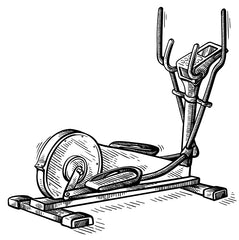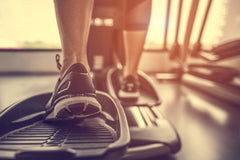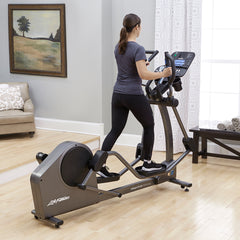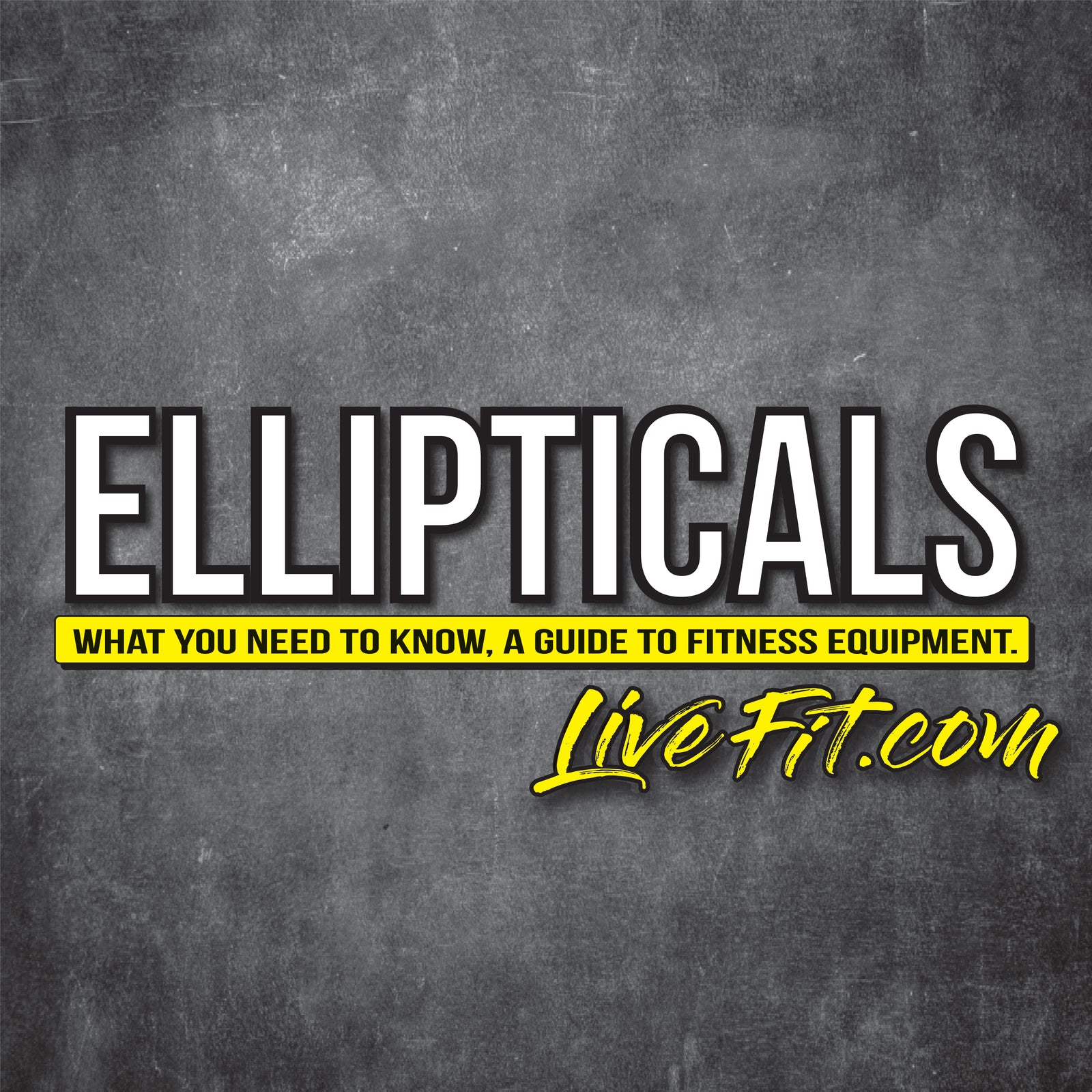In this in-depth elliptical buying guide, you'll learn:
- The Purpose of the Elliptical
- The components of an elliptical
- What questions to ask when shopping for an elliptical How to spot false & misleading fitness equipment advertising
- How to find the best place to buy an elliptical
Remember, we are always available to answer any questions about buying an elliptical or other exercise equipment. No time to research? Use the Virtual Assistant and one of our elliptical specialists will reach out to you with customized recommendations and our top picks for your personal needs. You can also use the button below to chat with an elliptical expert or visit a G&G showroom.
So, you have decided to purchase an elliptical trainer for your home.
Let's take care of a few things before we get started...
If you're anything like me when it comes to purchasing decisions, you are probably spending a fair amount of time on the web researching the parts of an elliptical, specification sheets & reviews, looking at photos, and watching videos. All of the information out there can be a bit daunting, so let us help you identify the most important aspects to consider and separate what you need to know from the gobbledygook when shopping for an elliptical trainer.
Read through at your own pace or choose a topic:
Purpose of an Elliptical | Front vs. Rear Drive | Frames
Stride Length | Resistance | Electronics |
Move-able Arms | Linkages | Suspension Systems
Also a brief disclaimer: we am not being paid by anyone to write this, and there is no compensation for us to recommend any specific brand(s). It is our sincere intention to assist you as you go down the long road of finalizing the decision that is best for you and fits in your price ranges. There is a lot of misinformation on the Internet as well as many complex variables to consider. A lot of companies with poorly-designed machines will bombard you with unrealistic fake testimonials and reviews, videos and photographs. As with any large purchase, it's always best to consult an expert. A word of advice: This buyer's guide will teach you everything you need to know about ellipticals. But, we always recommend you try it before you buy it! Click here to find a G&G Store near you.
Are you ready to learn why the elliptical is one of the most popular pieces of cardio fitness equipment in both homes and gyms? Then, let's get started!
The Purpose & History of the Elliptical
It is important to understand the origins of the elliptical trainer when you are shopping for one, because it may help you better understand exactly you are trying to get out of it. Perhaps knowing why the elliptical was invented and how it became so popular in such a relatively short period of time will help clarify any preconceptions you may have.
 In the early 90's, a gentleman by the name of Larry Miller had a daughter with a gift. She was an exceptional tennis player and had a bright future ahead of her, and Larry wanted to do everything he could to flush that out. Ultimately, Larry wanted to help improve his daughter' overall cardiovascular and fitness capacity but save her from the high impact workout drills typically associated with doing that, and possible injury and stress on her joints. Larry would record his daughter running in real time and watch the tape on his VCR. He would take a dry-erase marker and trace her footpath on his television screen. After mapping the overall ellipse of his daughter's stride as closely as possible, he developed a basic (and somewhat crude) prototype machine around the way she moved. And the elliptical was born.
In the early 90's, a gentleman by the name of Larry Miller had a daughter with a gift. She was an exceptional tennis player and had a bright future ahead of her, and Larry wanted to do everything he could to flush that out. Ultimately, Larry wanted to help improve his daughter' overall cardiovascular and fitness capacity but save her from the high impact workout drills typically associated with doing that, and possible injury and stress on her joints. Larry would record his daughter running in real time and watch the tape on his VCR. He would take a dry-erase marker and trace her footpath on his television screen. After mapping the overall ellipse of his daughter's stride as closely as possible, he developed a basic (and somewhat crude) prototype machine around the way she moved. And the elliptical was born.
Larry caught the eye of Precor, a fitness equipment manufacturer located near Seattle. Over the course of three years, they worked with Human Performance and Wellness, Inc. and the University of Oregon to determine what benefits users would experience, as well as a comparative analysis of other cardiovascular fitness equipment products on the market. Even more importantly though, how would the low impact cardio workout machine be perceived by its users?
One of the most fascinating aspects at the conclusion of their research was the significant decrease of the users' rate of perceived exertion (RPE) without any loss of workout quality. It was groundbreaking, plain and simple. A person could get optimal caloric expenditure and oxygen consumption and be much more comfortable while doing their cardio workout when compared to other products on the market. Make no mistake – you can get an excellent full body workout on an elliptical machine, and you can go longer, faster, harder and use it more frequently, all because of the workout variability and reduction of impact. In 1995, the unique modalities of Precor's brand new “EFX,” with its adjustable crossramp and ability to go backward, changed the name of the game in the fitness industry. And it hasn't been the same ever since.
What are the key components to look at when shopping for an elliptical?
- Drive System: Front vs. Rear Drive
- Elliptical Frame Construction
- Stride Length
- Resistance System
- Electronic Options
- Stationary or Move-able Arms
- Linkages
- Suspension Systems
Front Drive vs. Rear Drive – What's the Difference? Is One Better than the Other?
Get ready to stand up for the interactive part of our lesson on Elliptical drive systems.
 The very first elliptical, Precor's EFX 544, utilized a rear-drive design. The overall supposition was that when the flywheel is behind the user, it is more bio-mechanically correct. There are a few reasons why this idea was generally accepted: when the flywheel is behind the user, the user is required to pull it to make it go. Look at your side profile in a mirror and divide your entire body vertically down the middle. All of your anterior muscles (that face forward) are the muscles you use to push things. These include your pectorals and quadriceps. Your posterior muscles (that face backward) are the muscles you use to pull things. These include your back, glutes and hamstrings.
The very first elliptical, Precor's EFX 544, utilized a rear-drive design. The overall supposition was that when the flywheel is behind the user, it is more bio-mechanically correct. There are a few reasons why this idea was generally accepted: when the flywheel is behind the user, the user is required to pull it to make it go. Look at your side profile in a mirror and divide your entire body vertically down the middle. All of your anterior muscles (that face forward) are the muscles you use to push things. These include your pectorals and quadriceps. Your posterior muscles (that face backward) are the muscles you use to pull things. These include your back, glutes and hamstrings.
This is important and you should really understand this concept if you want to know the difference between a front and rear drive elliptical machine. So we are going to do a little experiment.
Stand Up and Try This!
 Now stand back up and rest for a second because we are going try it again. But this time, I want you to get off the balls of your feet, and set back on your heels. Put all your weight on your heels now and squat down again, using the same form. Hold that position for several seconds and listen to what your legs are saying (or screaming) to you.As you read this I want you to stand up and give yourself a little space. Stand with your feet at shoulder-width apart, turned outward about 30 degrees and with your knees aligned with your toes. Now, put all of your weight on the balls of your feet. You can even lift your heels off the floor slightly to ensure you are doing it correctly. Now squat down slowly. Don't round your back . . . keep it straight, stick your butt out and look directly ahead. Squat down as low as you can comfortably go, and hold that position for several seconds. Don't stand back up right away. Make sure to keep your knees behind your toes the entire time. Now pay attention. Where do you feel it most? If you are doing it correctly, you should absolutely start to feel a burn in your quads, and it won't take long at all. Do you feel it there?
Now stand back up and rest for a second because we are going try it again. But this time, I want you to get off the balls of your feet, and set back on your heels. Put all your weight on your heels now and squat down again, using the same form. Hold that position for several seconds and listen to what your legs are saying (or screaming) to you.As you read this I want you to stand up and give yourself a little space. Stand with your feet at shoulder-width apart, turned outward about 30 degrees and with your knees aligned with your toes. Now, put all of your weight on the balls of your feet. You can even lift your heels off the floor slightly to ensure you are doing it correctly. Now squat down slowly. Don't round your back . . . keep it straight, stick your butt out and look directly ahead. Squat down as low as you can comfortably go, and hold that position for several seconds. Don't stand back up right away. Make sure to keep your knees behind your toes the entire time. Now pay attention. Where do you feel it most? If you are doing it correctly, you should absolutely start to feel a burn in your quads, and it won't take long at all. Do you feel it there?
Where did you feel it this time? You should have felt it primarily in your hamstrings and glutes, and the burn in your quads should all but have disappeared. Why did that happen? You're doing the same movement, right? Your distribution is the key.
This is very similar to what you will experience on an elliptical depending on where the flywheel and drive axles are located and where the resistance comes from. Front drive elliptical machines are like that first squat you did - anterior – because you are required to push the flywheel to make it turn. Because you have to push it, you'll be more on the balls of your feet and using your quads.
Rear drive ellipticals are more similar to the second squat you performed. The wheel is behind the foot pedals and you are pulling it to make it turn, so it's posterior, which means you will more naturally want to drive through your midfoot or heel, recruiting your hamstrings and glutes (which is exacerbated with the addition of a crossramp).
Now, why is this so important?
There are a couple of points that come into play here, and the following two tidbits are primary reasons why a lot of professionals will commonly tell you that a rear-driven elliptical is generally “better” (although “better” is still relatively subjective).
 First, it's a proven higher overall workout efficiency. Different folks use different means to assess how efficient their training sessions are, and for this example, we will use overall caloric expenditure because that is the most widely-used metric. You should know that when it comes to calorie burn and muscle recruitment, bigger is better. Your hamstrings are about three times the size of your quadriceps, and your gluteus maximus is the largest muscle in the body. Those muscles, when contracted, will result in a higher caloric output requirement than your smaller anterior muscles such as your quads. Not only that, but you'll get the benefits of increased blood flow and nutrient transport as well.
First, it's a proven higher overall workout efficiency. Different folks use different means to assess how efficient their training sessions are, and for this example, we will use overall caloric expenditure because that is the most widely-used metric. You should know that when it comes to calorie burn and muscle recruitment, bigger is better. Your hamstrings are about three times the size of your quadriceps, and your gluteus maximus is the largest muscle in the body. Those muscles, when contracted, will result in a higher caloric output requirement than your smaller anterior muscles such as your quads. Not only that, but you'll get the benefits of increased blood flow and nutrient transport as well.
Second, when you are using an elliptical machine, you want your spine to be in a neutral position. This is one of the most important things I look for when I fit my client to an elliptical. You don't want to be excessively leaning forward the entire time you are on the machine, which puts undo stress on your lower back and stress on your joints. Typically, it is considered by professionals that a rear-driven elliptical trainer naturally puts you in a straight and upright position. This is because you are pulling the wheel, so your feet are flat in the foot pedals and your posterior chain muscles are doing most of the work. You won't have to consciously correct your posture when using a rear-driven elliptical because the machine is designed around the natural way your body operates. Since front-driven elliptical machines require you to push the wheel to make it turn, you will be more likely to be on the balls of your feet more and using more anterior muscles, resulting in the natural tendency to lean forward.
If rear drive is better, why are they the least common type?
 It's because when Precor invented the EFX elliptical and put it to market in 1995, they filed somewhere around 250 patents on their new machine. The rear-drive system was one of them, and they only license it out to a handful of companies. Inversely, it is worth noting that some front-drive manufacturers have taken big steps to counteract the effect of pushing the wheel, and a few of them have done an excellent job. One company puts you at a low, static incline to set you back so you don't lean forward. Another changes your overall articulation and range of motion so you bring your knees up higher to work your glutes and stand more upright with adjustable incline.
It's because when Precor invented the EFX elliptical and put it to market in 1995, they filed somewhere around 250 patents on their new machine. The rear-drive system was one of them, and they only license it out to a handful of companies. Inversely, it is worth noting that some front-drive manufacturers have taken big steps to counteract the effect of pushing the wheel, and a few of them have done an excellent job. One company puts you at a low, static incline to set you back so you don't lean forward. Another changes your overall articulation and range of motion so you bring your knees up higher to work your glutes and stand more upright with adjustable incline.
Still, just because there is a common belief about something doesn't mean you won't have to adjust to every single elliptical you try, regardless of what is considered to be “better.” This is why it is a good idea to ask a professional fitness consultant in your area to fit you to a machine that flows best with the way you uniquely move, and have them explain it all to you in great detail. This way, you can minimize the adaptiveness you will have to contribute on your end over long and frequent workouts and for many years ahead. These things tend to snowball and from my experience, it's one of the big reasons why an elliptical that doesn't fit you correctly could be a potential clothes-hanger in the future; you won't enjoy the experience if it is uncomfortable, right?
Are you more likely to use something less comfortable?
Not All Elliptical Frames are Made the Same
The frame is the skeleton of the machine, and depending on how the machine is constructed (wheel on ramp vs. suspension system) the frame will have a huge impact on how the machine feels under you. When you use an elliptical in a way that requires you to output high levels of intense energy, you are going to create a lot of force that the frame will be required to absorb.
 If you look at the machine where two pieces of steel are joined, check to see if bolts or welds are used. Welds will be much stronger at those connections because welds will maximize the integral strength of the steel due to no unnecessary tightened pressure created by bolts. Also, bolts will loosen over time, and welds will not. Be careful though, because not all welds are equal, and you want to look for full welds around the entire connection, as opposed to spot-welding.
If you look at the machine where two pieces of steel are joined, check to see if bolts or welds are used. Welds will be much stronger at those connections because welds will maximize the integral strength of the steel due to no unnecessary tightened pressure created by bolts. Also, bolts will loosen over time, and welds will not. Be careful though, because not all welds are equal, and you want to look for full welds around the entire connection, as opposed to spot-welding.
Also, this is something that will require a little investigative work by you, but knowing what types of steels are used can be very important. Some manufacturers use carbon steel frames with little-to-no heat treating process to strengthen the steel which results in a a very low Rockwell hardness. Also carbon steel is highly susceptible to rust, and because the electrolytes in your sweat are corrosive, that means a lot of preventative maintenance is going to be required of you. Higher quality machines that are designed to be used intensely and over long periods of time will use high-speed steels that have been strengthened by heat treating processes and use materials that are more impervious to rusting, such as air hardened steel, electrostatic powder-coating, stainless steel and aluminum extensions on exposed parts of the frame in high-sweat areas.
Lastly, the overall weight of the machine itself should be a good reference for you as to the integrity of its construction and its ability to hold up to the demands of being used regularly and intensely. Light and compact machines are designed around lower costs and minimizing your space restraints and personal inconveniences; and heavier, more robust machines will hold up more often when you need them to, and be more comfortable to use.
Stride Length Significance
 A lot of review sites out there on the web talk about how important stride length should be, and frankly, I think it is highly over-rated. There are a few reasons why. Many review sites will beat you into submission with the importance of stride length, because most of those websites have ulterior motives to direct you to specific products and/or brands. This is called affiliate marketing. It is unfortunate, but it is true, and it is a big problem in the fitness equipment industry. They talk about stride length a lot because they have to sell you their products somehow and some way, and they don't really have a whole lot else to talk about, with respect to bio-mechanics and ergonomics. Stride length is something that's easy to construct an intangible value around, and these companies and paid review sites are betting that the average consumer will not take into account some of the more complex considerations that make stride length moot. Here are few examples for you:
A lot of review sites out there on the web talk about how important stride length should be, and frankly, I think it is highly over-rated. There are a few reasons why. Many review sites will beat you into submission with the importance of stride length, because most of those websites have ulterior motives to direct you to specific products and/or brands. This is called affiliate marketing. It is unfortunate, but it is true, and it is a big problem in the fitness equipment industry. They talk about stride length a lot because they have to sell you their products somehow and some way, and they don't really have a whole lot else to talk about, with respect to bio-mechanics and ergonomics. Stride length is something that's easy to construct an intangible value around, and these companies and paid review sites are betting that the average consumer will not take into account some of the more complex considerations that make stride length moot. Here are few examples for you:
- There's a large emphasis on the user's height in correlation with appropriate stride length. This is incorrect. In all actuality, the user's hip index number as well as their own respective desired pace should be a more important factor when considering “appropriate” stride length. Two people who are both six feet tall will likely have different stride lengths because the distance from the ground to their hips is highly unlikely to be exactly the same.
- The overall range of motion and angle of the elliptical pattern could sabotage the so-called effectiveness of what a company states as their idea of optimal stride length. Because all ellipticals are designed substantially different from one another, Company A's 20-inch stride is going to feel completely different than Company B's 20 inch stride because of bio-mechanical design, pedal articulation, range of motion, position of linkages, flywheel and drive axles, types and locations of resistance systems, and so on. Knowing this, stride length should now become more of a trivial consideration in the overall purchasing decision. What's more important is a focus on how far the knees, hips and ankles bend while in motion; yet companies and paid review sites continue to lift up stride length as one of the most important factors when comparing ellipticals! Look at it this way: a school bus and a Ferrari can both go 20 MPH, right? Even though the speed is the same, is it going to feel the same driving a school bus at 20 MPH and driving a Ferrari at 20 MPH? Nope! They are two completely different products of engineering designed with two completely different objectives in mind. Given that information, the speed you are trying to travel now becomes inconsequential when you are shopping for a Ferrari in a parking lot full of school buses.
- Are you really getting a better workout because Company A has a 1 or 2-inch difference in stride length over Company B? The answer is no, you are not. And if you want proof, stand up and take a few long steps, and then go climb a flight of stairs. Which elevated your heart rate more quickly? Taking long, flat steps or climbing the stairs? The stairs did it, of course, and they'll do it every time. Your pace stayed the same but your muscle recruitment and required energy changed dramatically. And your stride actually gets shorter when you climb! If the primary reason why you are shopping for an elliptical is cardiovascular exercise, and you are comparing a machine with a longer stride versus a machine with a crossramp, and your heart rate, RPE and resistance levels are all equal, the added modality of the crossramp will give you better cardiovascular results than the simple adjustable stride. And the kicker is, when you climb, your stride actually gets shorter! So much for the significance of stride length!
 Still, to be devil's advocate, one could present an argument based on performance. If a user is only covering “x” amount of distance for each step they take, it will take longer for them to cover a specific distance when compared to running outside, because their natural stride is longer than the elliptical can provide. It's a tad unfair, because now you are using your elliptical machine outside of the scope of its purpose. What you're doing is driving the school bus like it is a Ferrari, but it doesn't have the same suspension. It doesn't have the same acceleration. It doesn't have the same brakes. It's apples and oranges. Ellipticals aren't running machines. Treadmills are running machines. Ellipticals are cross trainers, and if you use the elliptical they way it is designed to be used, stride length becomes much less important.
Still, to be devil's advocate, one could present an argument based on performance. If a user is only covering “x” amount of distance for each step they take, it will take longer for them to cover a specific distance when compared to running outside, because their natural stride is longer than the elliptical can provide. It's a tad unfair, because now you are using your elliptical machine outside of the scope of its purpose. What you're doing is driving the school bus like it is a Ferrari, but it doesn't have the same suspension. It doesn't have the same acceleration. It doesn't have the same brakes. It's apples and oranges. Ellipticals aren't running machines. Treadmills are running machines. Ellipticals are cross trainers, and if you use the elliptical they way it is designed to be used, stride length becomes much less important.
Also comfort is absolutely important because you need to be comfortable as you use the machine. I won't overcomplicated it for you and try to make it as simple as possible. Your formula for assessing the degree of importance for stride length to ensure optimal comfort as you shop, should look something like this:
Does the machine have an adjustable ramp?
| YES | NO |
| Your stride length automatically changes appropriately depending on the ramp angle, so stride length is a non-factor. over a fixed-stride elliptical. | Because the motion is fixed, flat and does not change, a machine with adjustable stride will allow you to find comfort at desired pace over a fixed-stride elliptical. |
Don't completely ignore the stride length, let it be one of the many factors that contributes to your overall purchasing decision. Just don't let it be one of the most important ones!
Types of Elliptical Resistance Systems
1. Manual Friction Brake
Manual Friction Brake systems are operated by the user turning a knob, which tightens down a brake pad on the flywheel. This system is one of the most simple and cost effective ways of applying resistance. It is also the least reliable and requires the most preventative maintenance. This system is not as common as it used to be however, as newer technologies have become more sophisticated and cost effective. Still, there are manufacturers today producing equipment that use extremely high quality friction brake systems and they should not be dismissed simply because they use friction for resistance. Talk to your local fitness consultant about the pros & cons of friction resistance and why/how they are not all equal.
2. Manual Magnetic Brake
Manual Magnetic Brake systems work similarly to manual friction systems, however in lieu of applied friction, it uses a magnet. When the user turns a knob or pulls a lever, a U-shaped bracket with a magnet attached to it is moves closer or farther away from the flywheel. The closer the magnet is to the flywheel, the more resistance is applied. It's more practical than friction resistance, for the most part, because you don't have wear and ongoing maintenance. You want to be careful though because not all magnets are the same quality, and just because it is magnetic does not mean it is going to have powerful resistance. Try the machines out for yourself at your local specialty showroom and compare the different resistance systems. Make sure to match your workout goals with the appropriate system that best meets your needs.
3. Eddy Current
Eddy Current systems work similarly to a manual magnetic system, however the magnet moves with the push of a button. Inside the machine is a curved arm bar with magnets attached to it, evenly spaced from the flywheel. Because this system is controlled electronically, the additional magnets will allow for more resistance that a manual system where the user has to physically turn a knob or move a lever. Just like a manual magnet, there will still be a small gap between the flywheel and the magnet when maximum resistance is applied . . . so there is no wear or friction. All of this equals an elliptical which lasts longer for you.
4. Electromagnetic Induction
Electromagnetic Induction Brake systems are the most powerful and sophisticated resistance systems out there today. Instead of using moving magnets, the magnets are fixed in place and as such, no moving parts. The magnets are fixated evenly with the flywheel spinning in between them. When the user increases the resistance, a higher electrical current is exposed to the magnets which makes the wheel harder to turn. Because the current is what determines the magnetic power (as opposed to the current remaining the same while the magnet moves closer and father away from the flywheel), the user has access to much more powerful resistance with an electromagnetic system. In addition, now you genuinely have no moving parts, and as such, less that could possibly go wrong in the future. Lastly, your resistance changes are instantaneous; meaning, when you go from level 1 to level 20 it will immediately respond. In moving magnet systems, you have to wait on the magnet to get closer to the wheel (which could take upwards to 30 seconds).
Elliptical Electronic Options, Features & Programs (And A Brief Tangent)
A common phrase I hear when talking about electronics is, “bells and whistles.” From my experience and general observations, people who use this term are referring to features integrated on the unit's console apparatus.
First things first here. For you to be able to find the right machine that fits your needs, you are going to need to concretely determine what it is you are trying to accomplish. Console workout programs are designed specifically around these personalized decisions, and unfortunately, I find that they are not talked about nearly as much as they deserve to be. These could include but are not limited to: entertainment options, number and types of workout programs, heart rate control and feedback, fitness apps metric feedback, memory features such as user profiles and workout calendars, USB and/or Bluetooth connectivity, speakers, touchscreens, cross training options and personalized coaching. Fair enough! However, when you say to me that you don't need any “bells and whistles,” and you are referring to the console options, what I am actually hearing – as YOUR fitness consultant – is that you have not put any detailed thought into the path to your fitness goals!
Here's an example of a high-end fitness equipment console from Matrix Fitness.
Hear me out. What I am saying is this: if you have a specific goal to drop your pace so you can achieve a better result at your next 5k, and you put some logical thought into accomplishing that goal and formulate a plan of action, you might say to me, “I really need something with a pacer function so I can monitor where I am at all times.” Or, if you are trying to lose a pound a week and keep it off, and you know how you are going to accomplish that goal, you might say, “I really need something that has a calorie goal program.” What if you are trying to lower your resting heart rate? You would say, “I really need to monitor my heart rate and do intelligent workouts designed to strengthen my heart.”
Point being, all of the options that are integrated into an elliptical's console are not fluff; each program and feature has a specific purpose designed around your specific goals, and to also motivate you.
Commodity shoppers will commonly look at these console features as the first expendable option when the cost of the machine is their primary focus. When my client starts to dismiss the console as a pretext to get the best value for their money, it is very important to me that I ask them follow-up questions to make sure that they aren't falling into the stigmatized “bells and whistles” trap and that they are not sabotaging their own goals before they even get started. Some of the most common feedback statements I receive when I ask for their thoughts are:
-
I don't use any of that stuff, I just get on it and go
-
I don't need to monitor my heart rate, I've never done it
-
It's just me using the machine, I don't need any user profiles or anything like that
These are not made up statements to fit the agenda of my argument, these are actual deflections from clients that I hear all of the time. And believe me when I say I know they aren't being unreasonable. I empathize with my clients. I want them to use their machines and get the most out of them. I want the machines to improve their lives and their health. I'd never argue with a client about their objections. All I try to do, really, is to fit them with a machine that best fits their needs before they automatically dismiss anything for the wrong reasons. And most of the time, I can help by asking one very simple question:
How valuable is your time?
I am just as busy as anyone and I can tell you with honesty that I wouldn't be able to get through the day if I did not optimize my time. A common reason (but not the only reason) why our clients are shopping for equipment for their home is because they don't have time to go to the gym. If this is also the case for you, and you told me this when I asked why you are shopping for an elliptical, I already know your time is valuable before I even ask!
It's fairly easy to overcome all of the objections stated above with just talking about how the elliptical can optimize your workout efficiency in the shortest time possible:
-
“You told me you want to burn 500 calories five days per week to lose a pound per week and keep it off. Instead of hitting Quick Start and working out for one hour, what if you tried this comprehensive interval program instead and finished in 30 minutes? Would an extra 30 minutes a day to get some other stuff done help you out?”
-
“I know you said you don't monitor your heart rate, but by doing this target heart rate program, you could really focus on torching fat first and foremost, and by staying in that zone the entire time, you could shave a few minutes off that traditional steady state workout in which it sounds like you have conditioned yourself.”
-
“I know you said it's just you using the machine and you don't need any user profiles, however if you save your information into a profile, you won't have to type in your age and weight every single time you start to exercise, which will save you lots of time.”
My contention really, is that the more options you have at your disposal, the more likely you will be to hit your goals, and the more you will use your elliptical for years to come. A fitness goal is a journey, and it's going to have ups and downs, and anything that will help you use the machine more frequently, and go longer, faster and harder . . . will shorten that journey.
How do you start shopping for an elliptical?
The best advice I can give you is to reach out to your local fitness equipment specialty dealer and speak with a reputable fitness consultant. Trust me, they want to hear from you and they want to talk about you and your fitness goals. Tell them what you are trying to achieve and let them work with you to create a plan of action to get you there. Fitness consultants are exceptional at gathering information about you, your career, your lifestyle, your family, your habits and your strengths and weaknesses and designing an optimal plan that is realistic and one that you will enjoy doing. And sometimes, that plan relies on specific and comprehensive workout programs that are integrated on the machine. Programs designed to optimize the benefits of using the elliptical. Programs designed to save you time. Not a bell. Not a whistle.
Movable Arms & Non-Movable Arms
 The majority of ellipticals out there have moveable arms that are inter-connected to the pedals and resistance system to provide a fluid, dual-action upper body workout. There are two main types of arms: those which are considered to be standard, which protrude straight ahead of the body when pushed and/or pulled. Non-standard converging arms, which converge toward the center of the body, tend to mimic a more natural walking or running motion.
The majority of ellipticals out there have moveable arms that are inter-connected to the pedals and resistance system to provide a fluid, dual-action upper body workout. There are two main types of arms: those which are considered to be standard, which protrude straight ahead of the body when pushed and/or pulled. Non-standard converging arms, which converge toward the center of the body, tend to mimic a more natural walking or running motion.
Fixed arm elliptical trainers have no moving arms at all, and are a little less common nowadays. They are primarily lower-body workouts, and people who don't like to use the arms regularly and have them move back and forth tend to gravitate toward fixed-arm machines.
Hybrid armed elliptical trainers are the least common. These ellipticals are optimal for workout variety because the arms can be docked in place so they do not automatically move back and forth if you don't want to use them.
Linkages
The linkages, where two pieces of steel are joined, make up a considerable amount of integrity of the machine. More cost-effective machines will use bushings, which use two pieces of material (typically brass, steel or plastic) which pivot on each other. Bushings wear over time, and will increase in noise and friction with more and more use.
Bearings are significantly smoother and require very little maintenance. You will usually find bearings on ellipticals in specialty stores, as opposed to department stores. Instead of having two flat pieces rub against one another, rounded bearings reduce the coefficient of friction, which results in less heat, noise and wear.
Wheel-on-Ramp vs. Suspension Systems
Some elliptical manufacturers utilize wheels that are directly connected to the pedals, which roll up and down a grooved track. Sometimes, these wheels are curved and other times they are not. Also, some companies use a single track for each pedal, and others use a dual track for curved wheels. For the most part, the idea is centrally the same: for the machine to provide the elliptical motion, it is dependent on the wheels moving back and forth, up and down the track(s).
Suspension ellipticals have no wheels. Instead, The pedals have their own independent pivot points (some also independently articulate) which are connected directly to linkages, which in turn are directly connected to the flywheel. They are called suspension systems because you are “suspended” in the air as you pedal the machine. Manufacturers design machines this way because they want the machine to have less maintenance required, and have them be significantly quieter than a wheel-on-ramp design.
I am an advocate that whatever machine is most comfortable and fits you best is likely to be the machine you will get the most benefits from, and that biomechanics and ergonomics trump mostly everything else. Still, there are a couple significant differences between the two types of systems that you should consider, and while I don't think one is “better” than the other, I think that by taking these things into consideration, it will help make you decision making process a bit less convoluted.
-
A wheel-on-ramp system is going to be noisier, as you will hear the wheels “whooshing” up and down the tracks.
-
A wheel-on-ramp system is going to require more preventative maintenance from you, because you are going to have to keep the tracks clean and free of debris. In addition, the wheels are a wear item.
-
A suspension system is quieter than a wheel-on-ramp system and does not have the wear items or require the preventative maintenance. However, the catch is that now regarding energy displacement, the machine is being stressed more. When you use an elliptical that has wheels moving back and forth on a track, you are evenly distributing the energy you are outputting along the entire track and/or ramp. However on a suspension elliptical, all of that energy has nowhere to go except for the linkages, so there is more stress being applied to those pivot points. Also, because most ellipticals use bolts to connect the arm masts, there is additional pressure being applied, and the bolts will likely loosen over time and need tightened again.


8 comments
Love this! Thank you for sharing!
Your guideline is good. This article is really informative and good work. thanks for sharing with us. This article is helpful to me.
Great article! It gave enough information that I feel confident in shopping for an elliptical that will meet my family’s needs. Most helpful was the info on fitness goals.
Pills information for patients. What side effects? where buy lisinopril without prescription Everything about medication. Read information now.
What do you know about ramp elevation?
Is it standard?
We would need more personal information in order to recommend a specific model. However, the brands we represent are consistently recognized as the leading brands in fitness equipment. Generally, if you stick with one of our brands you should be alright. Our best advice is definitely to visit a fitness equipment specialty dealer if you have one near you and stay out of the big-box stores. You can find a full selection of our ellipticals here: https://livefit.com/collections/ellipticals. Hope that helps!
I’m also interested in your answer to Ian’s question. This article was very helpful, but i live in California and can’t go to G&G. Any recommendations on model or even brand? Thank you!
In view of all the consideration, what the best elliptical in the market today would you recommend from a price range of midsize entry level for home use? Precor or Life Fitness?